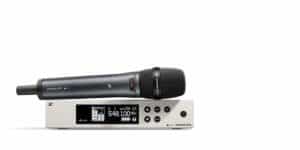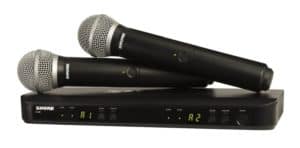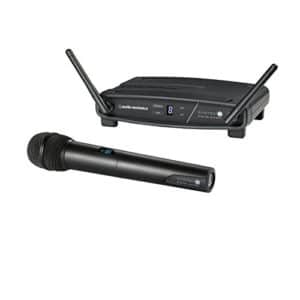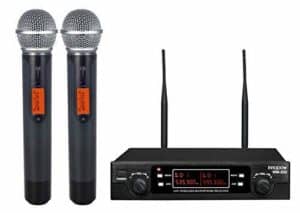Best Wireless Microphone in 2024
We take a look at the best wireless microphone out there.
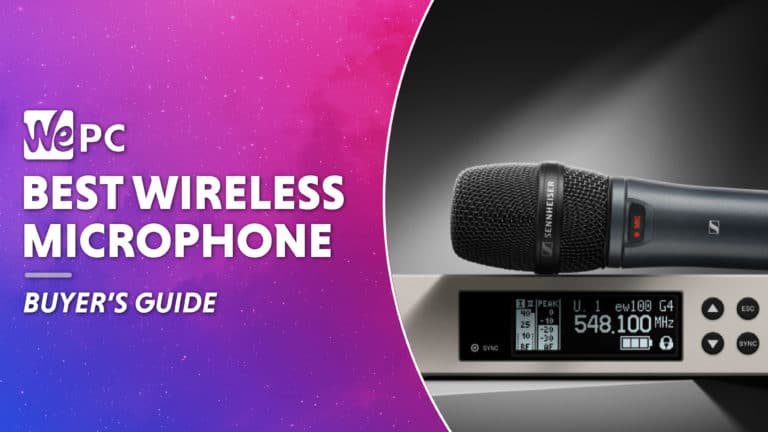
Wireless microphones offer users a lot of extra benefits and more professionals are switching over, which shows they are becoming a more reliable option. As the technology improves we see a decrease in interference issues and those pesky dropouts which sometimes plagued wireless technology as a whole.
In this article, we are going to go through the 5 best wireless microphones in 2024, see what pros and cons they might have, see how they stack up against the competition, and how reliable they are.
Wireless microphone systems are being used more and more in the field for live performers and this is largely down to the technology being more stable with noise-free transmissions and convenience making them a more attractive option.
As the technology gains in popularity, it has also become much more affordable for the general user with microphone systems offering high-level performance at a much lower cost.
Our Top Picks
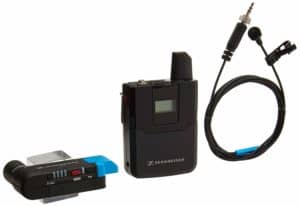
Things To Consider
What microphone you buy is obviously going to be down to what you are planning for its use. Whether it’s for commentating, singing, speaking, streaming on Twitch or YouTube, or reporting it is important to get the best wireless microphone to suit.
What Is A Wireless Microphone?
Your classic microphone works by converting an audio signal into an electric signal. A wireless microphone works in much the same way, however, instead of sending this signal to the amplifier via cable, it is done by radio waves to a receiver.
The wireless mic has been a godsend for performers, journalists, lecturers, and public speakers as it allows for a bit of freedom of movement in whichever domain it is being used. So those trip hazards are gone and there is some variety in types of wireless microphones currently available which we will cover just below this section.
Different Types Of Wireless Microphones
Handheld Microphone
The handheld microphone is probably the first one we think of and it’s often the main choice for music performers, public speakers, and comedians as long as there isn’t a rigorous dancing routine! It is perfect for comedians on stage as it can be passed easily between performers and one or two can be enough. The transmitter on a handheld mic is located inside so it is normally one unit and it transmits to the receiver which will be within its optimal range.
Headset Microphone
The headset microphone looks similar in a way to a call center operator or gamers headset. It may look and work in the same way but the quality and power will be significantly higher with this being a common choice among stage performers as it gives them a hands-free experience. The headset is usually connected to a transmitter often referred to as a bodypack.
Lavalier Microphone
This wireless mic system is more common with live television or public speaking events with lecturers and guest speakers. The mic is normally clipped to the person’s top/jacket underneath the neck and is connected like the headset mic via a bodypack transmitter. Just like the headset mic, the lavalier mic transmits to the wireless receiver.
Pickup Patterns
There are quite a few different types of microphone pick-up patterns and they are each suited for specific tasks.
Omnidirectional mics as you may have worked out from the name can pick up sound from any direction and you often seen them used in conference rooms, on the move reporting, and ambiance recording. Omnidirectional mics are flexible however they can pick up unwanted noise from the surrounding environment.
A cardioid mic is technically unidirectional but it does pick up a bit more than say a lobar mic which we will go into shortly. It picks up more due to its heart-shaped pattern which picks up some noise from the side however most noise is coming from the front. This makes cardioid mics great for live performances as it barely picks anything up from behind.
Hypercardioid mics are similar to a cardioid however they tend to pick up more noise from the back, making them less effective for live performances but still good enough for your tv documentaries or instrument recording in a studio. This is because they can cope with louder sounds much better despite the back rejection being weaker than cardioids. Super and Hypercardioid mics have a narrow sensitivity area which has a higher resistance to feedback. Despite working in a similar way, a Supercardioid mic would be better suited for filmmaking. They are a bit easier to use and this is down to their ability to isolate audio whilst giving you a small margin of error to work with when compared to standard shotgun mics.
The lobar pickup pattern is achieved with a shotgun mic and is unidirectional. Shotgun mics are produced for the most directional pickups as they cope with noise from the surrounding directions. These mics are encased in a tube-like capsule which rejects the noise from the sides effectively. These types of microphones are great for film narrative, controlled sets, group singers, or in film making but you would need a highly-skilled operator to ensure there are no dips.
Battery Life
Anything wireless is going to require some form of battery power. These Wireless mic systems usually will feature built-in rechargeable batteries and some may take disposable. Either way, this can take up extra money and time when you compare to a wired microphone plus it needs to be monitored so it doesn’t run out of juice at the worst moment.
Budget
Wireless microphones are not cheap unless you want to compromise on the quality of course. Our budget recommendation is the lowest we suggest going thanks to its glowing reviews. Like most tech the more you spend the higher quality you expect to get but just make sure it matches your individual needs and you don’t buy something overkill.
Multiple mics being used at once
If you are just buying a wireless mic for your setup at home to aid in video work you may only need a single microphone. You may need one for singing which involves more than one singer so you will need to buy a mic system that can handle the amount you wish to use at any one time.
Range
For home use, the range may not be the biggest factor to consider however at an event on a stage where the receiver is quite far away the range becomes very important. You need a strong range to limit interference noise and to cut through large crowded environments, so ensuring you have more range than you need is definitely a good idea.
Wired Vs Wireless
A wired microphone is usually accepted as a more reliable and therefore better all round device when compared to its wireless counterpart, which can be said about a lot of different technologies. This is normally the case due to a lack of interference from the wireless signals of a poor quality microphone or even in some cases the batteries.
Wireless microphones and receivers could get interference from other devices radio waves which can cause huge issues, however, over time these issues do slowly fade with technology advancing regularly.
The benefits of being wireless are normally for your performers, whether it’s a live artist who is quite active on the stage, a magician, or a guest on a live tv show they all need some freedom to move. You will find talk shows on tv tend to use wireless mics for any interview segments and that is because the wireless systems are a lot tidier due to a lack of cables. You can also clip wireless microphones to clothing too which comes in handy for guests and presenters alike.
The Our Top Wireless Microphone Picks
In-depth Review

- High quality
- Solid aluminium construction
- Features a mute switch
- Expensive
The Sennheiser EW 100-935S wireless microphone is a handheld dynamic mic which features a supercardioid pickup pattern. This microphone would be preferred by vocalists thanks to its improved clarity.
The combination of a highly sensitive microphone and the high-end wireless system make this a solid option for beginners and professionals alike. Feedback is eliminated on this making it perfect for singers and presenters plus it’s backward-compatible with previous evolution systems which won’t interfere with past investments.
It comes with a rackmount receiver which offers 1,680 tunable UHF frequencies over a 42MHz bandwidth for interference-free reception. This wireless mic system can be linked to twelve receivers simultaneously for an expanded setup if required. These can work for up to eight hours at a range of 100 meters again making them perfect for the big stage.
You can tune the handheld receiver to the EM 100G4 receiver with a simple push of a button which is a nice feature. There is a mute switch featured on this which always comes in handy for eliminating those pesky unwanted sounds.
This wireless mic handles noise expertly and whether you are presenting or singing you are getting professional sound support. If you are looking for a high-quality dynamic microphone, that is exactly what you are getting from Sennheiser here with its smooth and natural sound.
- One-touch QuickScan frequency selection
- Rugged and reliable
- Great value
- Includes two PG58 handheld transmitters
The Shure BLX288 wireless microphone system is considered to be one of the best in terms of value. The set comes complete with 2 x PG558 handheld transmitters and a dual channel receiver. The handheld transmitters are dynamic and feature a cardioid pickup pattern.
This package is perfect for vocalists and the setup is really simple. The duality offers users a bit of extra room in the sound rig as two transmitters can be used through one receiver making it quite a flexible wireless mic system. These systems from Shure are extremely reliable and they are perfect for the stage whether it’s the lead singer or a backing singer.
The device comes with Shures 1-touch QuickScan which will automatically find you the best frequency saving you time and making the system much more user-friendly. These come with an XLR and quarter-inch jack outputs, adding to the flexibility of the product. The range isn’t quite as good as the Sennheiser mic system but 91 meters is plenty and they broadcast on a 24MHz bandwidth. You get visual indicators that will let you know the status of the battery life which is pretty good at 14 hours but some have said they can last even longer.
These wireless mics are extremely robust and ooze quality. You are getting a dual-channel system which makes it a great setup for quite a few different situations and the ease of use makes them ideal for beginners and pros alike!
- Fast setup
- Optimised dynamic range
- High quality and reliable
- AVX plugs directly into the XLR
- Expensive
Sennheiser’s AVX wireless microphone system is a top drawer solution for video recording. This condenser lavalier setup is perfect for replacing the camera’s onboard microphone and with a receiver that plugs straight into the camera’s XLR audio connection, it saves time and battery!
The mic system operates at 1.9GHz and will stay out of range for other transmissions that can sometimes cause interference. The receiver turns its self on/off when it detects power from the camera saving you battery power when shooting which is a huge plus for this device.
This industry-standard mic system is lightweight making it unobtrusive and effective in any environment. This doesn’t just suit the cameraman this can be perfect for interviews for the radio too. The range is big enough (91 meters) to support some long-range recording, making it good for a lecturer or public speaker.
This works well straight out of the box with simpler connectivity than the previous versions. The battery life isn’t fantastic with 4 hours of life in the receiver and 15 in the transmitter but you can connect the power pack and charge on the go if you desired.
The small form factor of this mic system makes it ideal for the videographer with a small camera setup and the quality is of the highest we have seen, well worth considering.
- Easy to use
- Reliable
- Affordable
- Complete system
- Not a huge range
The ATW-1102’s from Audio-Technica is a high-quality, affordable option that comes as a complete system. It operates at the 24-bit/2.4GHZ range which means it functions in a separate range to TV and DTV, keeping it free from interference.
Both the transmitters and receivers feature an LCD display which is easy to read and further adds to the user-friendly nature of this system. The main downside to this other than the range is its poor battery life, you will only get up to around 5 hours of operation with this wireless mic setup. The system features XLR and a one-quarter inch output jack for use with a variety of audio equipment.
Similarly to the Shure system, this wireless mic can find the best frequency at the touch of a button which can be very useful in a multi-system setup as it can help avoid interference.
This wireless microphone system is great for public speaking, live performances, and smaller stages. This diverse system is extremely easy to set up whilst being a high quality yet affordable option.
- Dual cardioid microphones
- Solid construction
- 80 channels
- Battery life
- Not a huge range
- Budget
The Innopow 80-Channel Dual mic system is quite far from the top Sennheiser and Shure systems in a professional sphere. If your budget allows for the top two picks then they are highly recommended, but these offer some great value for what they can do.
These dynamic microphones operate at a max distance of 80 meters which is more than enough to use these on a stage and they have a cardioid pickup pattern making them perfect for public speaking and singing. Despite being a budget option the audio quality is fantastic, these handle quiet and loud noise exceptionally.
The construction as mentioned is solid with a nice heavy feel to the transmitters, making them a bit more resistant to any accidental drops or bumps. Unfortunately, the receiver can’t be mounted to a rack but for the price, it is reasonable enough to sort your own rig out with a bit of DIY.
The mics take AA batteries which don’t come included but the battery life is up to around 14 hours of continual use meaning these are highly unlikely to die at a gig.
This may not be the most professional system on the market but they are damn good for the price and are well worth the investment.
Final Word
The main benefits of a wireless microphone system are mostly freedom of movement. More and more are turning to these long-range cable-free options as they are increasing in power and are reasonably priced.
You get what you pay for and as you can see from the higher-end models in this list you get something of unrivaled quality for your cash. The lower-priced mic systems can sometimes compromise on noise rejection so make sure you 100% know what you require your microphone for before buying!
WePC is reader-supported. When you buy through links on our site, we may earn an affiliate commission. Prices subject to change. Learn more

